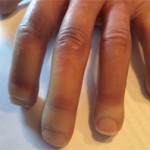The year was 1991. It was my first Tuesday as a rheumatology fellow at the University of Pittsburgh’s Presbyterian Hospital. Navigating a maze of buildings and hallways, I delivered myself to the entrance to the scleroderma clinic. Running late and not knowing whether there was a separate entrance for staff, I clicked open the door. The clinic space was eerily quiet. All business in my white lab coat and lobster necktie, I bustled through the waiting area. Looking neither to the right nor left, I focused on the gray carpet, aiming for a door adjacent to the check-in counter.
 A cough caught my attention, and half-turning, I made eye contact with a young woman whose woody face shook me to the bone. She had a loose, afghan sweater draped over her boney shoulders. An intravenous line tunneled through her neck, delivering a creamy solution from a plastic bag hooked onto a stainless steel pole. She smiled, but her mouth opened awkwardly, doll-like. Her smile was all teeth, the hide-bound skin of her cheeks resisting the upward pull of her lips. I waved awkwardly back. She pulled a claw-like hand out from beneath the afghan and flexed the fingers in reply.
A cough caught my attention, and half-turning, I made eye contact with a young woman whose woody face shook me to the bone. She had a loose, afghan sweater draped over her boney shoulders. An intravenous line tunneled through her neck, delivering a creamy solution from a plastic bag hooked onto a stainless steel pole. She smiled, but her mouth opened awkwardly, doll-like. Her smile was all teeth, the hide-bound skin of her cheeks resisting the upward pull of her lips. I waved awkwardly back. She pulled a claw-like hand out from beneath the afghan and flexed the fingers in reply.
Insights into the trigger(s) for diffuse scleroderma have been difficult to tease out. Genetic predisposition plays a role, but the rarity of the disorder, estimated at an annual incidence of only 19 cases per million, suggests that other risk factors may be in play beyond genetic risk alone.
Clinic Begins
Inside, and thoroughly unnerved, I settled into a swivel chair to review the day’s charts. My preceptor and chief of the Department of Clinical Immunology and Rheumatology, Thomas A. Medsger Jr., MD, a slender academic with thinning, gray hair with a hint of a combover, welcomed me to my first scleroderma clinic and reviewed the ground rules. I would have an hour for new patients, 15–30 minutes for follow-ups. For the new consults, he would review the case before final recommendations were made. For the follow-ups, it would depend on the complexity of the visit and my familiarity with the disease.
He pushed his glasses back from where they rested at the tip of his nose. “I know that, as a practicing internist for the past six years, you’ve amassed considerable clinical acumen. But as a new fellow, we don’t expect you to be knowledgeable regarding scleroderma. You might go an entire general internal medicine career without diagnosing a single case.”



